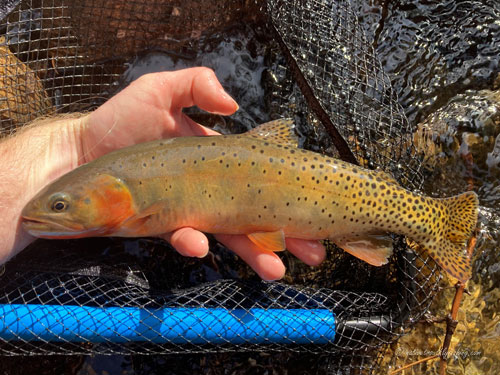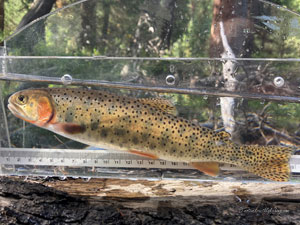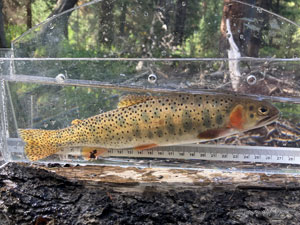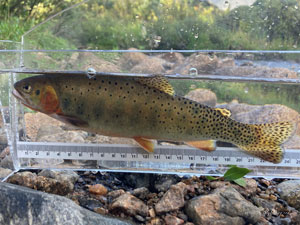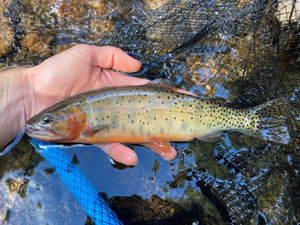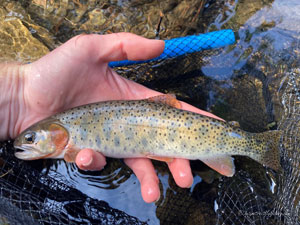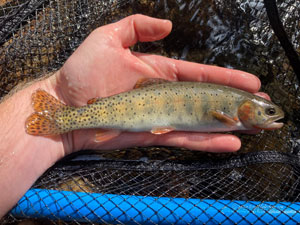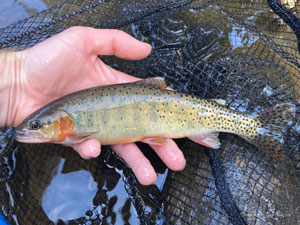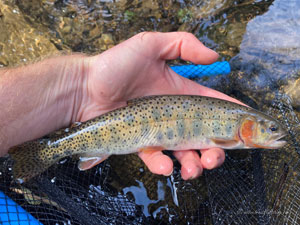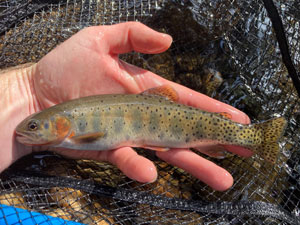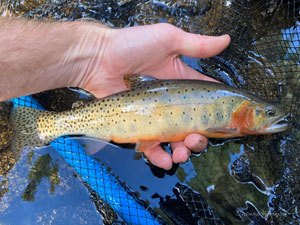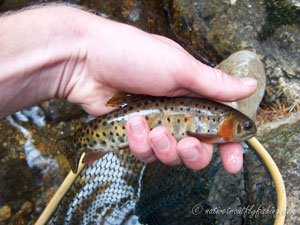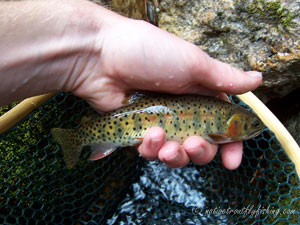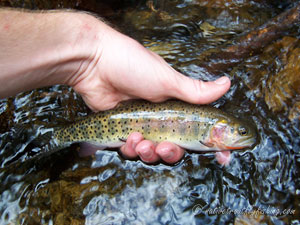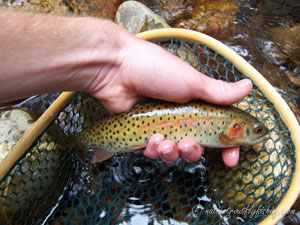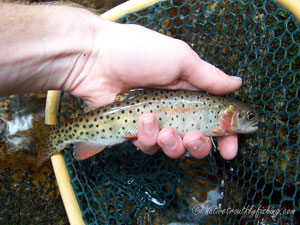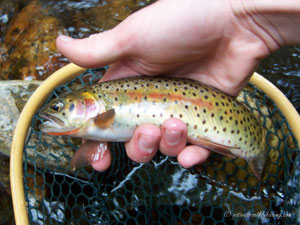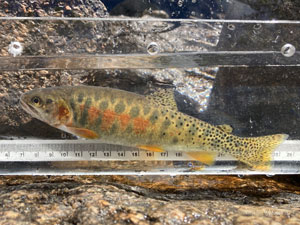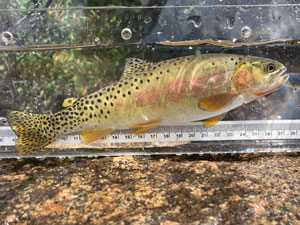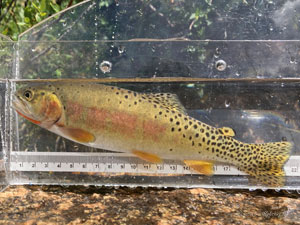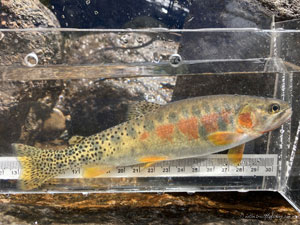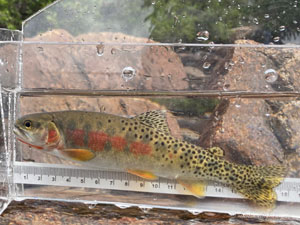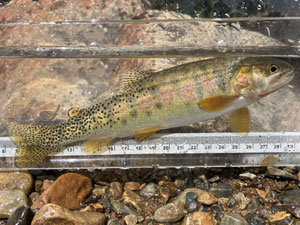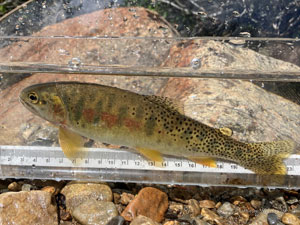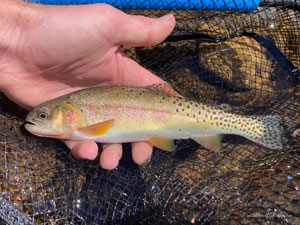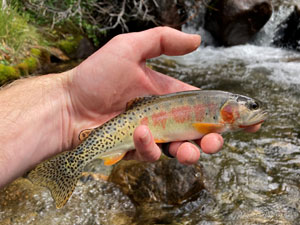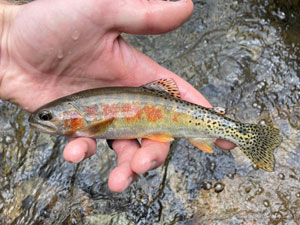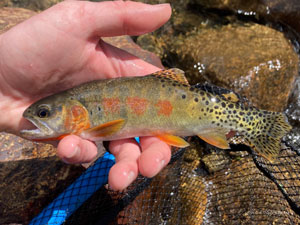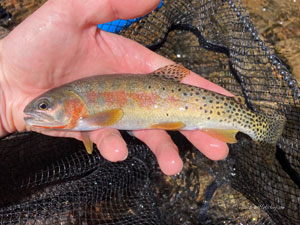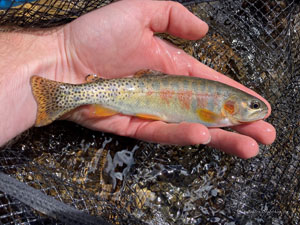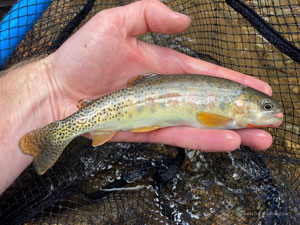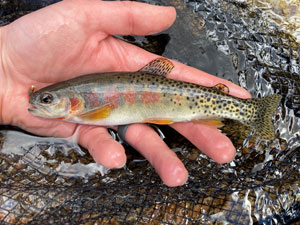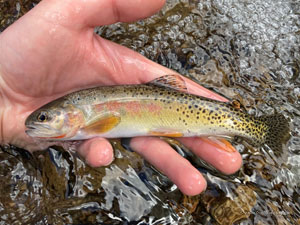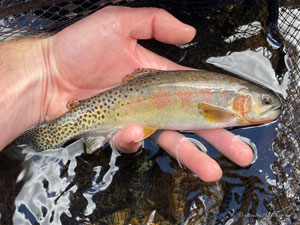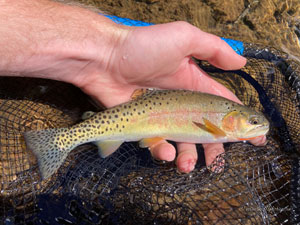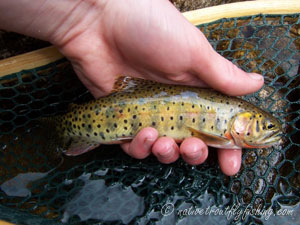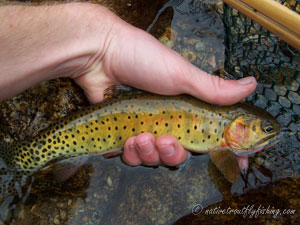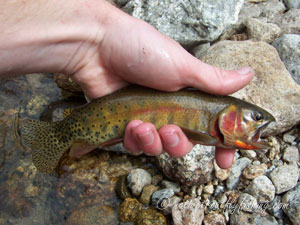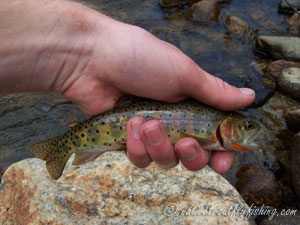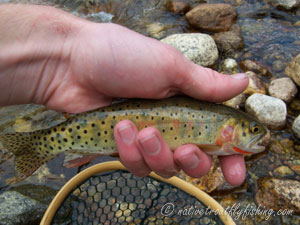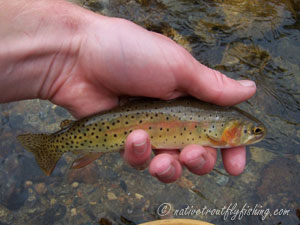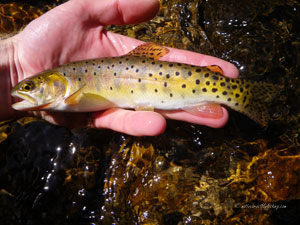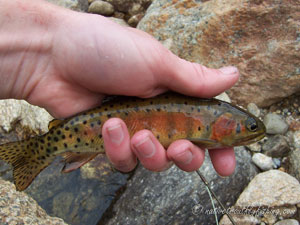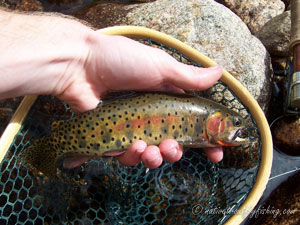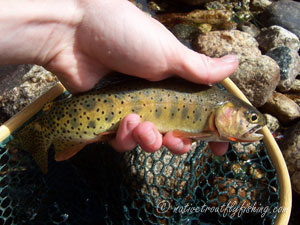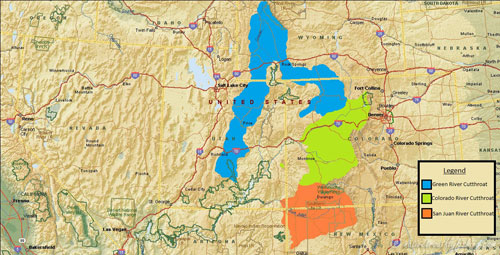Colorado River Cutthroat
Oncorhynchus virginalis pleuriticus
A Colorado River Cutthroat from a small stream in the upper Colroado watershed.
Introduction
The Colorado River Cutthroat is a subspecies of Rocky Mountain Cutthroat Trout native to the Upper Colorado, Gunnison and Dolores watersheds of Colorado and a small part of Utah in the La Sal Mountains (Metcalf 2012, Rogers et al. 2018, Trotter et al. 2018). Colorado River Cutthroat were also historically found in the Abajo Mountains of Utah as revealed by a hybridized population found in the upper reaches of Indian Creek, but no pure populations are believed to remain there today (Trotter 2008). Although they were originally misidentified as Greenback Cutthroat, Colorado River Cutthroat may also be native to the Arkansas River drainage in Colorado, although this is still a matter of debate (See Hayden Creek Cutthroat below). While most classification systems lump them together (Behnke 1992, Behnke 2002, Trotter 2008), there are three genetically distinct forms of Cutthroat native to the Colorado River basin, including San Juan Cutthroat, the Green River Cutthroat (referred to as the blue lineage) and the Colorado River Cutthroat (referred to as the green lineage), a fact that was masked by past stocking efforts (Metcalf et al. 2012, Rogers et al. 2018). It was in 2007, that the first signs emerged that the Colorado River Cutthroat were unique from the Cutthroat of the Green River drainage, even though it was not recognized at the time. A study by Metcalf et al. (2007) assessing the genetics of “Greenback Cutthroat” determined that the conservation populations of Greenback Cutthroat consisted of two distinct lineages. They designated these as the blue lineage for what they believed to be Colorado River Cutthroat and the green lineage for what they believed were Greenback Cutthroat. However, the discovery of a population of Cutthroat in the La Sal Mountains of Utah in 2009 that matched the genetics of the green lineage “Greenback Cutthroat,” as well as numerous other green lineage populations west of the continental divide raised questions of whether these fish were truly Greenback Cutthroat (Rogers 2008). This question was finally resolved in 2012, when DNA was extracted from museum specimens and revealed that the green lineage did not match the Greenback Cutthroat specimens but represented a formerly unrecognized subspecies of Cutthroat native to the upper Colorado River drainage (Metcalf et al. 2012). As it turned out, the Green River Cutthroat and Colorado River Cutthroat are quite distinct from each other and appear to have diverged approximately 1.2 to 1.7 million years ago and based on mitochondrial DNA Colorado River Cutthroat are more closely related to both the Greenback and Rio Grande Cutthroat than they are to the Green River Cutthroat (Shiozawa et al. 2018, Rogers 2020). Genetic evidence indicates that Colorado River Cutthroat are most closely related to San Juan Cutthroat, although the two lineages are genetically distinct enough to warrant being considered separate subspecies (Rogers et al. 2018, Shiozawa et al. 2018, Trotter et al. 2018). Today classification of the Colorado River Cutthroat has been made more challenging due to past stocking of Green River Cutthroat primarily from Trappers Lake throughout the upper Colorado, Gunnison, and Dolores watersheds and as such the majority of Cutthroat populations in these watersheds are introduced Green River Cutthroat (Albeke 2020, Rogers 2022).
Hayden Creek Cutthroat – Colorado River Cutthroat of the Arkansas Basin
A curious genetically and morphologically unique form of Colorado River Cutthroat is found in the upper Arkansas River, east of the Continental Divide (Bestgen et al. 2019, Rogers 2020). These fish were first documented in Twin Lakes, Colorado in 1889 (prior to widespread stocking in Colorado) as “Greenback Cutthroat” alongside the now extinct Yellowfin Cutthroat (Behnke 2002). Based on genetic analysis of the museum specimens, these “Greenback Cutthroat” were actually Colorado River Cutthroat, but hold unique genes not found in any known populations west of the Continental Divide (Metcalf et al. 2012, Rogers et al. 2018). While the population in Twin Lakes went extinct along with the Yellowfin Cutthroat, a population matching the genetics of the Twin Lakes Colorado River Cutthroat persisted further downstream in the Arkansas watershed in the South Prong of Hayden Creek until it was lost in fire in 2016. As the fire raged, biologists crossed the fire lines to rescue 158 trout from the stream before the monsoon rains sent an ash chocked debris flow through the watershed that eliminated all the remaining Cutthroat. These 158 fish were then used to start a captive breeding program and their offspring have now been planted into several streams throughout the Arkansas basin. It is still unclear how Colorado River Cutthroat ended up in the Arkansas watershed, but several scenarios have been proposed. The first is that they may have arisen from an undocumented transplant or water diversion and contain genetics that have since been lost west of the Continental Divide. While the undocumented stocking event is certainly a plausible as Rainbow Trout, Brook Trout, Lake Trout and Atlantic Salmon had all been stocked in Twin Lakes by 1889, a water diversion seems much less likely as the Colorado River Cutthroat in Twin Lakes were clearly already a thriving in the lakes by 1889. However, based on the current assessment of museum specimens, the Yellowfin Cutthroat and Colorado River Cutthroat in the lakes did not appear to hybridize, although evidence of this could still emerge as 22 of the museum specimens have not been sampled yet (Metcalf et al. 2012, Rogers et al. 2021). Alternatively, it can’t be ruled out that these Cutthroat represent a native population that invaded the upper Arkansas basin via a headwater transfer during the Pleistocene and evolved a sympatric relationship with the Yellowfin Cutthroat (Rogers 2021). Regardless of how they arrived these fish represent a unique piece of Cutthroat diversity and a lineage worth preserving.
Life History Information
The Colorado River Cutthroat's native range is typified by numerous high mountain lakes and cool mountain streams and rivers and as such these fish exhibited stream resident, fluvial (river migrant) and adfluvial (stream to lake migrant) life histories. Historically migratory populations were widespread across the native range of these fish, but today these life history forms are much less common with the fluvial form likely complete lost. The Colorado River Cutthroat has been rapidly displaced across much of its native range over the past century and most populations have been pushed back into isolated headwater streams, often above 8,000’ (2,438 m) in elevation. Due to this the stream resident form is currently the most prevalent life history strategy exhibited by these trout.
Stream Resident and Fluvial (River Migrant) Life History
Most of the remaining stream resident populations occur in small isolated high elevation streams with limited growth opportunities. As a result, Colorado River Cutthroat in these streams typically mature at small sizes and often only reach a maximum size of 8” (20 cm) (Behnke 2002). For example, fish in a small upper Colorado tributary reached just 6” (15 cm) by age-3 to age-4, while age-2 and older Cutthroat from a small stream on the Roan plateau in western Colorado averaged 7.8” (19.7 cm) (Scarnecchia and Bergersen 1986, Peterson et al. 2004). With the short growing season in these high elevations streams the trout feed opportunistically on a variety of aquatic and terrestrial insects. Colorado River Cutthroat typically spawn for the first time at age-2 as males and age-3 as females but may spawn at later ages in higher elevation streams (Trotter 2008). While Colorado River Cutthroat are spring spawners, in the high elevation streams that they a found spawning typically doesn’t occur until June or even mid-July when water temperatures reach 41 °F (5 °C) (Scarnecchia and Bergersen 1986, USFWS 1998). Female Colorado River Cutthroat from Como Creek (previously believed to be Greenback Cutthroat) on the eastern side of the continental divide typically spawn for the first time at age-3 to age-4 when they reach 7” (18 cm) and produce 1.5 eggs per gram of body weight (USFWS 1998, Coleman 2007). Fry emerge from the gravel between late-July and early October, and as with the growth limitations due to the short growing season, the cold temperatures in the upper Colorado River basin also limit survival and recruitment of fry in many populations (Coleman and Fausch 2007).
The little that we know about the migratory life histories of the Colorado River Cutthroat comes from historical accounts prior to the widespread introduction of nonnative species. These accounts from the late 1800's indicate that fluvial Cutthroat were once found in all of the larger rivers of the Upper Colorado basin and that some of these fish reached sizes of 5 to 7 pounds (2.3 to 3.2 kg) at an age of 6 to 8 years (Trotter 2008). It is thought that the life history of these fish was similar to that of other Rocky Mountain Cutthroat with migrations to lower elevation locations to overwinter, before migrating upstream to spawn as spring runoff subsided. After spawning, these Cutthroat likely reared in higher elevation locations in the mainstem watersheds opportunistically feeding on aquatic and terrestrial invertebrates as well as other fish throughout the summer, before moving back downstream in fall to their overwintering habitat.
Adfluvial (Stream to Lake Migratory) Life History
While Colorado River Cutthroat once inhabited numerous alpine lakes across their native range, their greatest adfluvial population was found in Grand Lake near Estes Park, Colorado. Little is known about this population, although accounts suggest that they were able to reach sizes of up to 20 lbs. (9 kg) (Behnke 2002). Additionally, the lakes of the Grand Mesa were also once a stronghold of adfluvial Colorado River Cutthroat, but even less is known about these populations. Another interesting adfluvial population of Colorado River Cutthroat occurred in Twin Lakes near Leadville, Colorado, although it is still unclear whether these Cutthroat were native or were introduced to the lakes from an undocumented stocking event (Rogers 2021). Until recently these fish were thought to have been Greenback Cutthroat, but genetic evidence revealed that they were a unique population of Colorado River Cutthroat (Metcalf et al. 2012, Rogers et al. 2018). Interestingly, this population occurred alongside the much larger now extinct Yellowfin Cutthroat and while the Yellowfin Cutthroat was reported to reach sizes of 13 lbs. (5.9 kg), the Colorado River Cutthroat only reached a maximum size of 10” to 12” (25 to 30 cm) in the lake (Jordan and Evermann 1889). It is hypothesized that these two Cutthroat were able to live in together in the lake via niche partitioning, with the Yellowfin Cutthroat preying on the smaller Colorado River Cutthroat which primarily fed on aquatic and terrestrial invertebrates (Behnke 2002). It is also believed that the two subspecies maintained reproductive isolation, with the Yellowfin Cutthroat spawning in shoals in the lake and tributaries shortly after ice out, while the Colorado River Cutthroat spawned in tributaries as runoff was subsiding (Trotter 2008).
Status
The Colorado River Cutthroat has suffered extensive declines across its native range over the past 150 years, primarily due to over-harvest, habitat degradation and the introduction of non-native fish. While it is only in recent years that scientist realized that Colorado River Cutthroat are unique from the Cutthroat of the Green River basin the decline of Cutthroat across the Colorado and Green River basins prompted calls for them to be listed as far back as the 1970’s (Behnke and Zarn 1976). The need for a coordinated recovery effort, eventually brought the states of Wyoming, Utah, and Colorado together in 1999 along with federal management agencies to sign a conservation strategy for Colorado River Cutthroat (CRCT 2001). This agreement provided a recovery framework for the Colorado River Cutthroat, by prioritizing actions and setting clear conservation goals. The same year that the conservation agreement and strategy was signed, the Cutthroat of the Colorado basin were also petitioned to be listed under the Endangered Species Act (USFWS 2000, USFWS 2004), although this petition was later determined to not be warranted (USFWS 2007). While the conservation agreement has resulted in significant recovery progress for the Green River Cutthroat, recovery of the Colorado River Cutthroat has a long way to go and today the Colorado River Cutthroat is found in just 69 conservation populations across (465 km) of stream habitat and a single lake, accounting for only 3% of their former native range west of the Continental Divide (Rogers 2020, Rogers 2022).
The greatest threat to the Colorado River Cutthroat has been the introduction of nonnative fish and case after case shows that once non-native trout are introduced into a stream containing Colorado River Cutthroat, within a few generations the Cutthroat are completely replaced by the invaders. Early introductions of nonnative trout were made in an effort maintain fisheries as Colorado River Cutthroat populations became depleted to habitat destruction and overharvest. Historical accounts indicate that Colorado River Cutthroat were harvested in vast numbers in the late 1800’s to feed the burgeoning mining camps throughout the Colorado Rockies with the heaviest toll on the fluvial and adfluvial populations. An example of this occurred in Grand Lake, where Cutthroat were seined out of the lake and were said to have been harvested by the wagon load. To support the depleted fishery, Rainbow Trout, Brook Trout, Brown Trout, Lake Trout and Kokanee were stocked in the lake and completely replaced the Cutthroat within just a few years (Trotter 2008). Similarly, fluvial populations of Colorado River Cutthroat appear to have disappeared quickly following the introduction of nonnative trout. For example, Rainbow Trout were introduced to the Upper Gunnison River in 1883 and by 1897 Cutthroat in the Gunnison River which were reported to reach sizes of up to 12 lbs. (5.4 kg) had all but vanished and the river became famous for its Rainbow Trout fishery (Behnke 2002).
The Colorado River Cutthroat were historically the only trout species found in the upper Colorado basin and due to their long isolation from other salmonids they are poorly suited to deal with introduced species. Competition and hybridization are the primary mechanisms leading nonnative trout species such as Brook, Brown, and Rainbow Trout to ultimately replace native Colorado River Cutthroat. Brook Trout, which have been widely stocked throughout the range of the Colorado River Cutthroat are a particularly problematic competitor. Unlike the spring spawning Colorado River Cutthroat, Brook Trout spawn in the fall, which means that their offspring emerge months prior to those of the native Cutthroat allowing them to reach larger sizes are monopolize the best rearing habit. While Cutthroat are able better cope with Brook Trout in cold high elevations streams, in warmer mid elevation streams, introduced Brook Trout result in a two-to-thirteen-fold reduction in the survival of young of the year Colorado River Cutthroat (Peterson et al. 2004). Rainbow Trout and other subspecies of Cutthroat spawn during spring like Colorado River Cutthroat and as such can interbreed with them and produce viable offspring. This results in a loss of the unique genetics of the native Cutthroat populations often leading to either a hybrid swarm with intermediate characteristics or complete replacement of the Colorado River Cutthroat. Of the 69 remaining populations of Colorado River Cutthroat west of the continental divide, 26 show some level of hybridization with either Rainbow Trout or Yellowstone Cutthroat and pure populations are only found in 155 miles (250 km) of stream habitat west of the Continental Divide. In addition to Rainbow Trout and Yellowstone Cutthroat, introductions of Green River Cutthroat (also known as blue lineage Colorado River Cutthroat) have also had a significant impact on Colorado River Cutthroat. Between 1903 and 1938 over 80 million Green River Cutthroat primarily from Trappers Lake were stocked across Colorado and effectively masked the fact that the Cutthroat of the upper Colorado basin represented unique subspecies (Metcalf et al. 2012, Rogers et al. 2018). As a result, all the Cutthroat populations west of the Continental Divide in Rocky Mountain National Park are dominated by Green River Cutthroat genetics instead of the native Colorado River Cutthroat (Stowell et al. 2015). This pattern is repeated, throughout the upper Colorado, Gunnison and Dolores watersheds and based on the most recent status review, 53% of the stream habitat utilized by Cutthroat within the native range of the Colorado River Cutthroat is currently occupied by introduced Green River Cutthroat (Albeke 2020, Rogers 2020).
Habitat degradation has also been a major factor leading to the decline of these fish and continues to be a problem in some drainages. Agriculture, logging, and road building have all had a slew of negative effects on Cutthroat populations in the Colorado basin, including increased sediment loads that reduce egg survival, barriers that block migration, dewatering of streams for irrigation, loss of riparian vegetation and increased summer stream temperatures. In addition to these factors, Colorado has a long history of mining, and the legacy effects continue to impact some populations to this day often limiting the productivity of already small fragile Cutthroat populations. Another looming threat to the Colorado River Cutthroat is climate change, the effects of which are already being felt with increased drought, wildfire risk, reduced snowpack, and lower, warmer stream flows during summer. Wildfires can be particularly dangerous for small, isolated Cutthroat populations and whiles the fires do not always directly eliminate the Cutthroat populations, they are often followed up by debris flows that do. This exact scenario occurred in 2016, when a wildfire burned through the South Prong of Hayden Creek, the only stream known to hold Cutthroat matching the museum specimens of Colorado River Cutthroat from Twin Lakes and the subsequent debris flows eliminated the population. In addition to direct effects from climate change, warmer stream temperatures are also expected to increase competition with Brook Trout and allow them further to invade Cutthroat streams across the Colorado and Green River basin. Based on this threat it is predicted that 122 populations of Green River and Colorado River Cutthroat will be lost by 2080 if additional management actions are not taken (Roberts et al. 2017). With Colorado River Cutthroat currently occupying just 3% of their native range, they face a long road to recovery, and it is going to take a serious concerted effort to see them thriving across their native range once again.
Description
The Colorado River Cutthroat is one of the most brilliantly colored of the subspecies of Cutthroat Trout. While their coloration varies from population to population, they typically have brassy-olive-colored backs, which transitions to a pale orangish-yellow or bronze-gold color along the sides. Some individuals exhibit a pale band of pink or orange along their lateral line and vibrant orangish-red color on their gill plates and the bellies sexually mature fish (especially males) may be a peach or bright orange color. The lower fins also often brightly colored and range from orange to peach colored. The spotting pattern is also variable, but most fish tend to have relatively large sparse spots on that are concentrated above the lateral line and towards the caudal peduncle. However, some individuals from the Hayden Creek population have relatively dense fine spots along their caudal peduncle. These Hayden Creek fish also exhibit a series of pinkish-red or reddish-orange blotches interspersed with parr marks, that may extend slightly beyond the dorsal fin along their lateral line. The lower fins on the Hayden Creek fish range from a peachy orange to a bright yellow. Juvenile Colorado River Cutthroat typically have 9-11 oval shaped parr marks, which fade as they reach maturity. Like their name suggests, these fish have bright orange cutthroat mark under their lower jaw.
Taxonomic Characteristics: Gill rakers average 18.5, with a range of 16-21. Pyloric Caeca average 37, with a range of 32-45. Scales along lateral line average 204, with a range of 190-229. Basibranchial teeth average 8, with a range of 1 to 23 (Bestgen et al. 2019).
Upper Colorado River - Stream Resident Form
Click on images to view a larger picture
Upper Arkansas River (Hayden Creek Cutthroat) - Stream Resident Form
Click on images to view a larger picture
Former Greenback Cutthroat - Colorado River x Green River Hybrids
Click on images to view a larger picture
Native Range
A map of the original native range of the Green River (Blue Lineage), Colorado River Cutthroat (Green Lineage) and San Juan Cutthroat Trout. Data Source: Behnke (2002) and Trotter (2008).Below: A map of the native range of the Colorado River Cutthroat Trout.
References
Behnke, R.J. and M. Zarn. 1976. Biology and management of threatened and endangered western trouts. USDA Forest Service, Rocky Mountain Forest and Range Experiment Station, Fort Collins, Colorado. General Technical Report RM-28.
Behnke, R. J. 1992. Native trout of western North America. American Fisheries Society Monograph 6. American Fisheries Society, Bethesda, Maryland.
Behnke, R. 2002. Trout and Salmon of North America. Chanticleer Press, New York.
Bestgen, K.R., K.B. Rogers and R. Granger. 2019. Distinct phenotypes of native cutthroat trout emerge under a molecular model of lineage distributions. Transactions of the American Fisheries Society 148:442-463.
Coleman, M.A. 2007. Life history and ecology of the Greenback Cutthroat Trout. Colorado State University. Fort Collins Colorado.
Coleman, M.A. and K.D. Fausch. 2007. Cold summer temperature limits recruitment of age-0 cutthroat trout in high elevation Colorado streams. Transactions of the American Fisheries Society 136: 1231-1244. https://doi.org/10.1577/T05-244.1
Jordan, D.S. and B.W. Evermann. 1889. Description of the yellow-finned trout of Twin Lakes, Colorado. Proceedings of the National Museum 12(780): 453-454.
Metcalf, J.L., V.L. Pritchard, S.M. Silvestri, J.B. Jenkins, J.S. Wood, D.E. Cowley, R.P. Evans, D.K. Shiozawa and A.P. Martin. 2007. Across the great divide: genetic forensics reveals misidentification of endangered cutthroat trout populations. Molecular Ecology 16(21): 4445-4454. https://doi.org/10.1111/j.1365-294X.2007.03472.x
Metcalf, J.L., S.L. Stowell, C.M. Kennedy, K.B. Rogers, D. McDonald, J. Epp, K. Keepers, A. Cooper, J.J. Austin and A.P. Martin. 2012. Historical stocking data and 19th century DNA reveal human induced changes to native diversity and distribution of cutthroat trout. Molecular Ecology 21(21): 5194-5207. https://doi.org/10.1111/mec.12028
Peterson, D.P., K.D. Fausch and G.C. White. 2004. Population ecology of an invasion: Effects of brook trout on native cutthroat trout. Ecological Applications 14(3): 754-772. https://doi.org/10.1890/02-5395
Roberts, J.J., K.D. Fausch, M.B. Nonnative trout invasions combined with climate change threaten persistence of isolated Cutthroat Trout populations in the southern Rocky Mountains. North American Journal of Fisheries Management 37: 314–325. https://doi.org/10.1080/02755947.2016.1264507
Rogers, K.B. 2008. Using amplified fragment length polymorphisms to characterize purity of cutthroat trout in Colorado: results from 2007. Colorado Parks and Wildlife, Steamboat Springs, Colorado.
Rogers, K.B., K.R. Bestgen, S.M. Love Stowell and A.P. Martin. 2018. Cutthroat trout diversity in the southern Rocky Mountains. Pages 323-341 in P. Trotter, P. Bisson, L. Schultz and B. Roper, editor. Cutthroat Trout: evolutionary biology and taxonomy. American Fisheries Society, Special Publication 36, Bethesda, Maryland.
Rogers, K.B., 2020. Cutthroat Trout studies: 2020 progress report. Colorado Parks and Wildlife. Fort Collins, Colorado.
Rogers, K.B., 2021. Cutthroat Trout studies: 2021 progress report. Colorado Parks and Wildlife. Fort Collins, Colorado.
Rogers, K.B., 2022. Cutthroat Trout studies: 2022 progress report. Colorado Parks and Wildlife. Fort Collins, Colorado.
Scarnecchia, D.L. and E.P. Bergersen. 1986. Production and habitat of threatened greenback and Colorado River cutthroat trouts in Rocky Mountain headwater streams. Transactions of the American Fisheries Society 115: 382-391. https://doi.org/10.1577/1548-8659(1986)115<382:PAHOTG>2.0.CO;2
Shiozawa, D. K., R. P. Evans, D. D. Houston and P. J. Unmack. 2018. Geographic variation, isolation, and evolution of Cutthroat Trout with comments on future directions for management and research. Pages 129-172 in P. Trotter, P. Bisson, L. Schultz, and B. Roper, editors. Cutthroat Trout: evolutionary biology and taxonomy. American Fisheries Society, Special Publication 36, Bethesda, Maryland.
Trotter, P. 2008. Cutthroat: Native Trout of the West. Second Edition. University of California Press, Berkley, CA.
Trotter, P., P. Bisson, B. Roper, L. Schultz, C. Ferraris, G.R. Smith and R.F. Stearley. 2018. A special workshop on the taxonomy and evolutionary biology of cutthroat trout. Pages 1-31 in Trotter P, Bisson P, Schultz L, Roper B (editors). Cutthroat Trout: Evolutionary Biology and Taxonomy. Special Publication 36, American Fisheries Society, Bethesda, Maryland.
Underwood, Z.E., C.A. Myrick and K.B. Rogers. 2012. Effect of acclimation temperature on the upper thermal tolerance of Colorado River cutthroat trout Oncorhynchus clarkii pleuriticus: thermal limits of a North American salmonid. Journal of Fish Biology 80: 2420-2433. https://doi.org/10.1111/j.1095-8649.2012.03287.x
USFWS (U.S. Fish and Wildlife Service). 1998. Greenback cutthroat trout recovery plan. United States Fish and Wildlife Service. Denver, Colorado.
USFWS (U.S. Fish and Wildlife Service). 2000. A petition for rules to list the Colorado River cutthroat trout (Oncorhynchus clarki pleuriticus) as threatened or endangered under the Endangered Species Act. Center for Biological Diversity, Tucson, Arizona.
USFWS (U.S. Fish and Wildlife Service). 2004. 90-Day finding on a petition to list the Colorado River Cutthroat Trout. Federal Register 69:21151.
USFWS (U.S. Fish and Wildlife Service). 2007. 12-Month finding for a petition to list the Colorado River Cutthroat Trout as Threatened or Endangered. Federal Register 72:32589.
Contact
Feel free to contact me if you have any questions or comments
Colorado River Cutthroat Trout Links
My Colorado River Cutthroat Trips
Colorado Department of Parks and Wildlife - Colorado River Cutthroat Trout
Rocky Mountain National Park - Fishing
Pike-San Isabel National Forests
Grand Mesa Uncompahgre and Gunnison National Forests
Arapaho & Roosevelt National Forests
Medicine Bow-Routt National Forests
Western Native Trout Initiative - Colorado River Cutthroat Trout
Trout Unlimited - Colorado River Cutthroat Trout
Native Trout Links
California Heritage Trout Challenge
Truchas Mexicanas' - Native Trout of Mexico
Balkan Trout Restoration Group
Trout and Seasons of the Mountain Village - About Japanese Trout
Fly Fishing Blogs
Dave B's Blog: Fly Fishing for Native Trout
The Search for Native Salmonids
Conservation Links
Western Native Trout Initiative
Fly Fishing Links
Fishing Art Links
Americanfishes.com - Joseph R. Tomelleri
